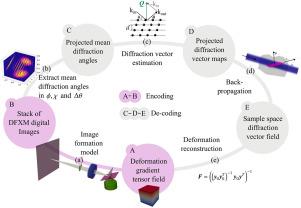暗场x射线显微镜与位错动力学建模的结合
IF 6
2区 工程技术
Q2 MATERIALS SCIENCE, MULTIDISCIPLINARY
引用次数: 0
摘要
利用合成的暗场x射线显微镜数据在三维空间重构变形梯度张量场(映射所有9个张量分量)。由于显微镜的独特特性,我们的研究结果表明,变形场的演变现在可以无损地成像,在原位,并在深嵌入的晶体元素。推导出的回归框架和采样方案在运动学衍射近似下运行,非常适合研究塑性变形过程中的微观结构演变。导出了从DFXM图像中提取的衍射矢量与样品变形梯度张量场唯一关联的变形条件。分析表明,反变形梯度张量场在由x射线束厚度和衍射射线路径定义的线段上必须具有有限的高阶空间导数。针对实际噪声水平的数值模拟验证了所提出的算法。模拟单一直边位错的重建表明,Burgers矢量分量可以以2%的误差恢复。重建的弹性变形场的平均绝对误差为10−6。利用弹性变形场的旋度,导出了局部位错密度,得到了亚像素精度的重构位错核心位置。在位错连续统理论的背景下,讨论了直接测量弹性变形和位错密度张量场的意义。这些测量还可以与连续位错动力学相结合,提供指导开发和验证的数据,从而将相关模型扩展到有限应变状态。本文章由计算机程序翻译,如有差异,请以英文原文为准。

Towards interfacing dark-field X-ray microscopy to dislocation dynamics modeling
Deformation gradient tensor fields are reconstructed in three dimensions (mapping all 9 tensor components) using synthetic Dark-Field X-ray Microscopy data. Owing to the unique properties of the microscope, our results imply that the evolution of deformation fields can now be imaged non-destructively, in situ, and within deeply embedded crystalline elements. The derived regression framework and sampling scheme operate under the kinematic diffraction approximation and are well-suited for studying microstructure evolution during plastic deformation. We derive the deformation conditions under which diffraction vectors extracted from DFXM images can be uniquely associated to the deformation gradient tensor field of the sample. The analysis concludes that the inverse deformation gradient tensor field must feature limited higher order spatial derivatives over line segments defined by the X-ray beam thickness and the diffracted ray path. The proposed algorithms are validated against numerical simulations for realistic noise levels. Reconstructions of a simulated single straight-edge dislocation show that the Burgers vector components can be recovered with an error of 2%. The mean absolute error of the reconstructed elastic distortion field was found to be . By taking the curl of the elastic distortion field, local dislocation densities are derived, yielding a reconstructed dislocation core position with sub-pixel accuracy. The significance of directly measuring the elastic distortion and the dislocation density tensor fields is discussed in the context of continuum theory of dislocations. Such measurements can also be interfaced with continuum dislocation dynamics by providing data that can guide the development and validation, thus extending the relevant models to finite strain regimes.
求助全文
通过发布文献求助,成功后即可免费获取论文全文。
去求助
来源期刊
CiteScore
9.80
自引率
9.40%
发文量
276
审稿时长
52 days
期刊介绍:
The aim of Journal of The Mechanics and Physics of Solids is to publish research of the highest quality and of lasting significance on the mechanics of solids. The scope is broad, from fundamental concepts in mechanics to the analysis of novel phenomena and applications. Solids are interpreted broadly to include both hard and soft materials as well as natural and synthetic structures. The approach can be theoretical, experimental or computational.This research activity sits within engineering science and the allied areas of applied mathematics, materials science, bio-mechanics, applied physics, and geophysics.
The Journal was founded in 1952 by Rodney Hill, who was its Editor-in-Chief until 1968. The topics of interest to the Journal evolve with developments in the subject but its basic ethos remains the same: to publish research of the highest quality relating to the mechanics of solids. Thus, emphasis is placed on the development of fundamental concepts of mechanics and novel applications of these concepts based on theoretical, experimental or computational approaches, drawing upon the various branches of engineering science and the allied areas within applied mathematics, materials science, structural engineering, applied physics, and geophysics.
The main purpose of the Journal is to foster scientific understanding of the processes of deformation and mechanical failure of all solid materials, both technological and natural, and the connections between these processes and their underlying physical mechanisms. In this sense, the content of the Journal should reflect the current state of the discipline in analysis, experimental observation, and numerical simulation. In the interest of achieving this goal, authors are encouraged to consider the significance of their contributions for the field of mechanics and the implications of their results, in addition to describing the details of their work.

 求助内容:
求助内容: 应助结果提醒方式:
应助结果提醒方式:


